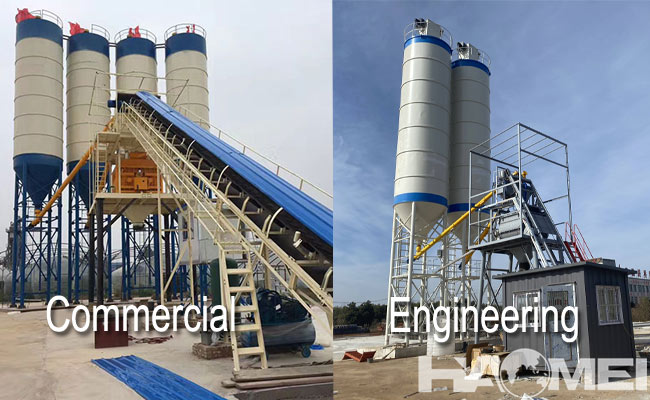Categories
- Case & News (50)
- Blog (565)
Commercial concrete batch plant and engineering concrete batch plant are two different types of concrete production facilities, mainly used to meet different concrete needs. Commercial concrete batch plant and engineering concrete batch plant have significant differences in use, equipment configuration, metering method, lifting method, environmental control and operation mode.

1. Concrete use
– Commercial concrete batch plant: for commercial purposes, produces and sells concrete to widely meet the needs of various customers, such as commercial ready-mixed concrete in urban and rural areas, roads and bridges, water conservancy, airports, ports and other large infrastructure construction projects and places with large concrete demand. The concrete grades it produces are diverse, ranging from C15 to C80, and can produce concrete of different grades according to different needs of users.
– Engineering concrete batch plant: concrete mixing equipment built for a specific project, the concrete produced is only used for the project and is not sold to the outside. It is usually built near the project, and the concrete grade produced is usually a fixed grade used for the project.
2. Equipment configuration
– Commercial concrete batch plant: the equipment configuration is relatively high to meet the needs of different users. It is usually equipped with a mixing system, aggregate supply system, powder storage system, metering system, control system and external supporting equipment. The mixing system uses a forced mixer, which can mix various types of concrete such as fluidity, semi-hardness and hardness; the metering system has high precision and can ensure the quality of concrete; the control system has a high degree of automation and can realize remote monitoring and operation. The typical model is HZS120 and above, with a theoretical output of up to 300 cubic meters per hour.
– Engineering concrete batch plant: The equipment configuration is determined according to the size and needs of the project and is relatively simple. Generally, it only needs to meet the production of concrete for the project, and there is no need to have high flexibility and multi-grade production capacity like commercial concrete batch plants. For example, common models include HZS25 to HZS120, with a theoretical output of 25-120 cubic meters per hour.
3. Metering method
– Commercial concrete batch plant: Generally, a metering bucket is used to measure aggregates, with high metering accuracy, which can ensure the accuracy of the concrete mix ratio. Concrete batch plants with a capacity of more than 50 cubic meters per hour mostly use the method of weighing each material independently. All weighings are controlled by electronic scales and microcomputers. The weighing accuracy of aggregates is ≤2%, and the weighing accuracy of cement, powder, water and admixtures is ≤1%.
– Engineering concrete batch plant: Generally, belt scales are used to measure and transport aggregates. The measurement accuracy is relatively low, but it can meet the needs of engineering self-use.
4. Lifting method
– Commercial concrete batch plant: Generally, inclined belt conveyors are used to lift aggregates. The conveying distance is large, the efficiency is high, and the failure rate is low. It is suitable for concrete batch plants with aggregate temporary storage bins, thereby improving the productivity of concrete batch plants.
– Engineering concrete batch plant: Bucket lifters are used to lift aggregates. It occupies a small area and has a simple structure, but the conveying efficiency is relatively low.
5. Site and flexibility
– Engineering concrete batch plant
Built near the construction site, it occupies a small area and is easy to dismantle and relocate. For example, large projects such as airports and bridges are often equipped with HZS120 concrete batch plant.
– Commercial concrete batch plant
It requires a long-term fixed site selection, usually located in the suburbs, with a large site scale, supporting aggregate silos, sewage treatment and other facilities to meet high production needs.
6. Economic efficiency and applicable scenarios
– Applicability of engineering concrete batch plant:
Suitable for projects with a short construction period (such as 2-3 years) and stable concrete demand (such as less than 200,000 cubic meters), such as highways and building construction projects, with cost control as a priority.
– Applicability of commercial concrete batch plant:
Suitable for areas with large market demand and diverse customer types, such as urban commercial concrete supply centers, to enhance competitiveness through high-precision measurement (aggregate error ≤2%, water agent error ≤1%) and diversified formulas.
Summary
– Commercial concrete batch plant: suitable for large-scale, long-term concrete production, providing various types of concrete, and serving multiple projects.
– Engineering concrete batch plant: suitable for temporary concrete production of specific engineering projects, with strong flexibility, mainly used to meet the needs of a single project.